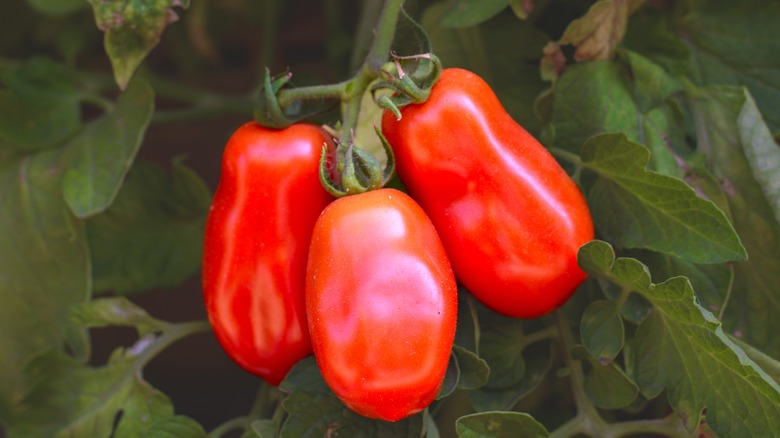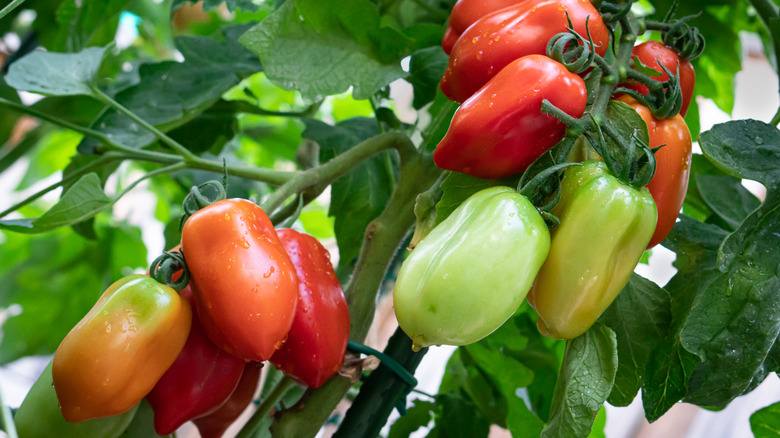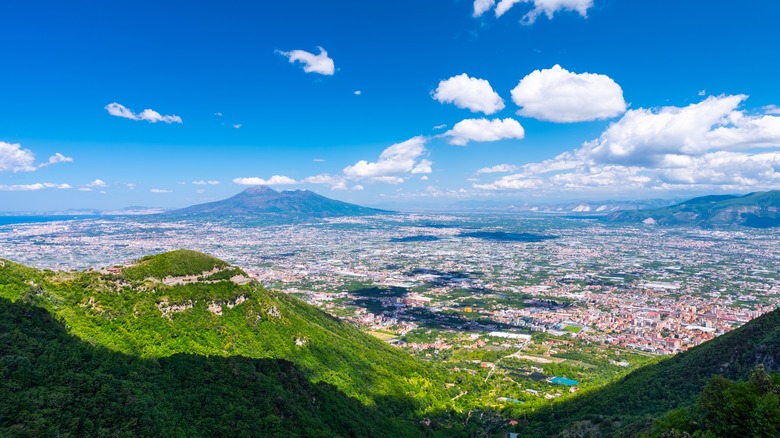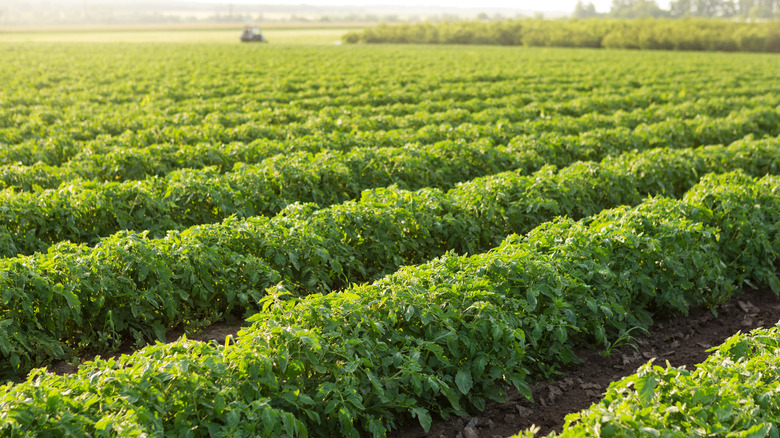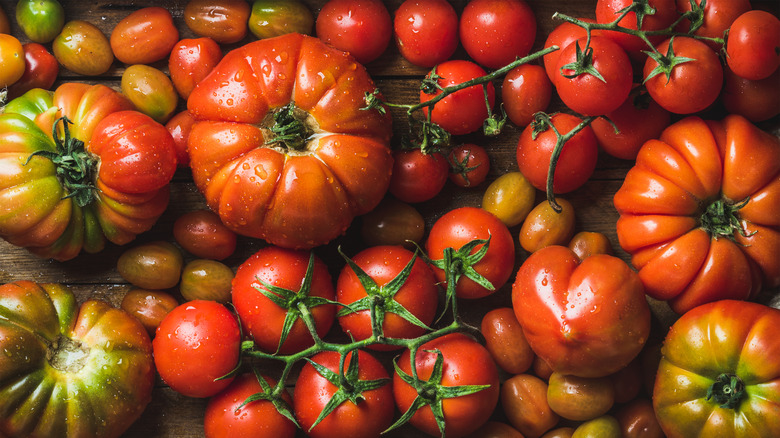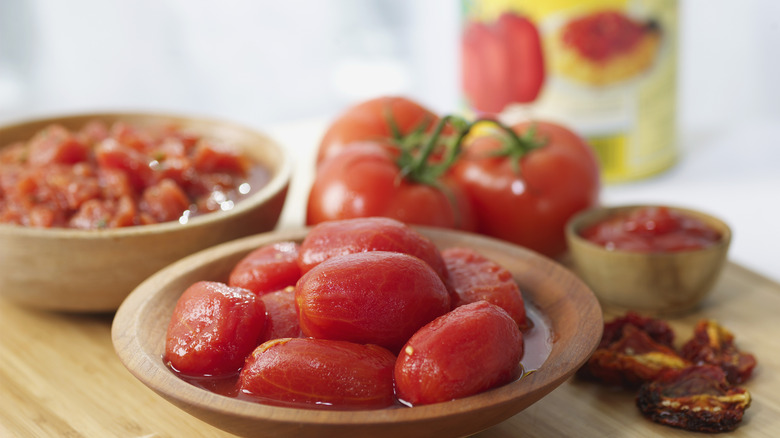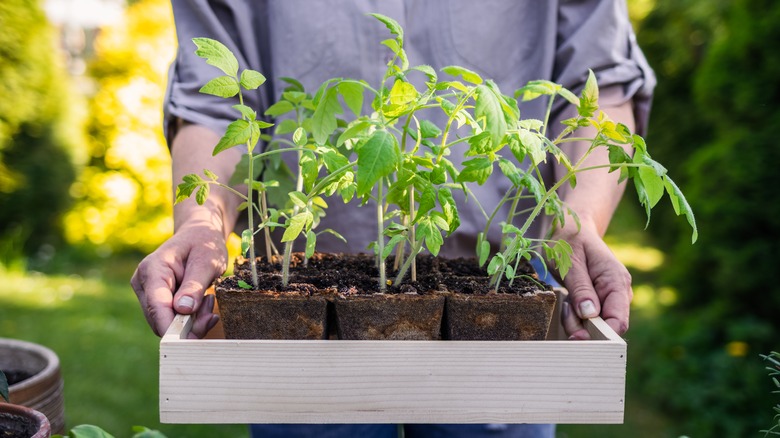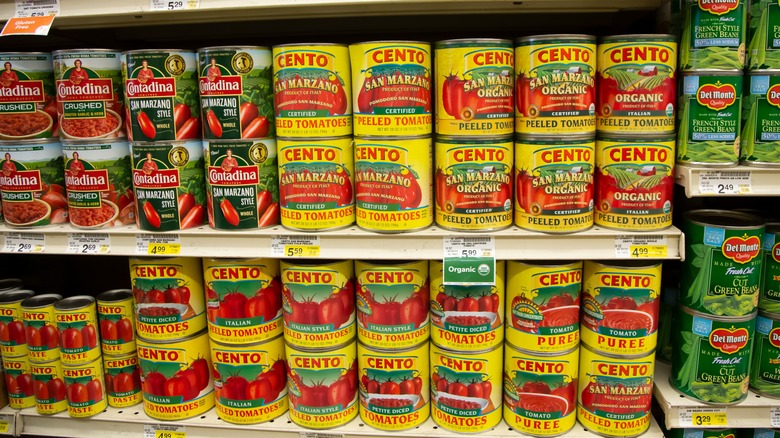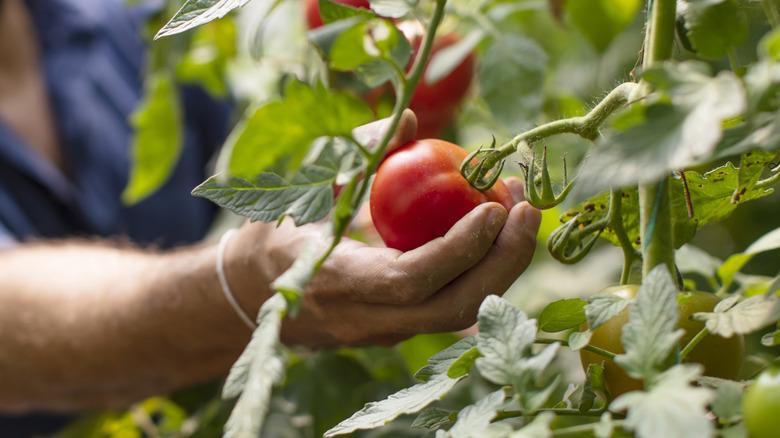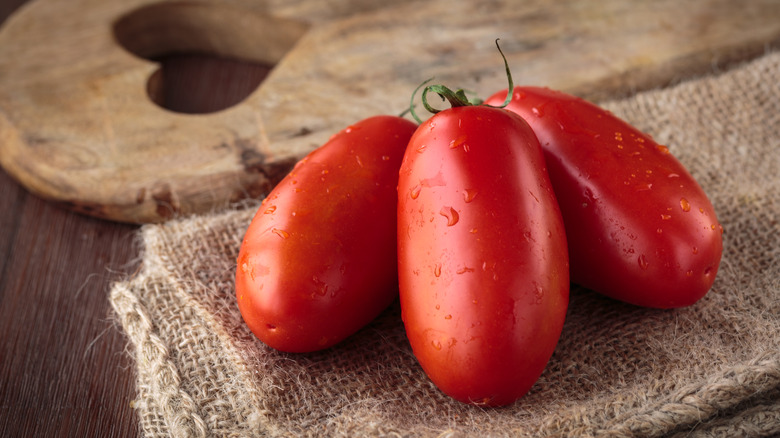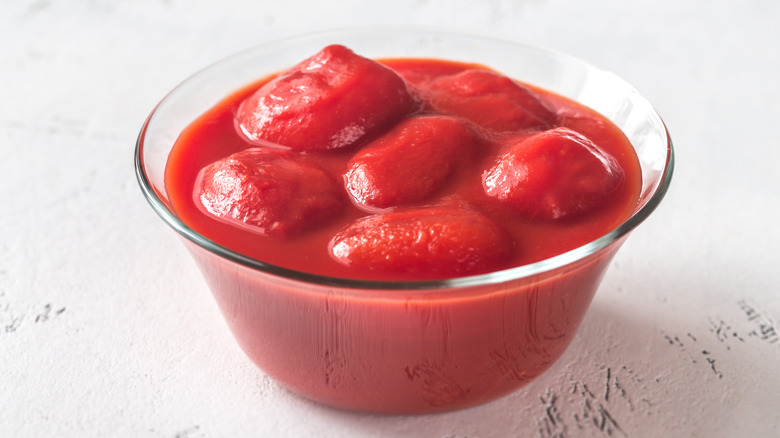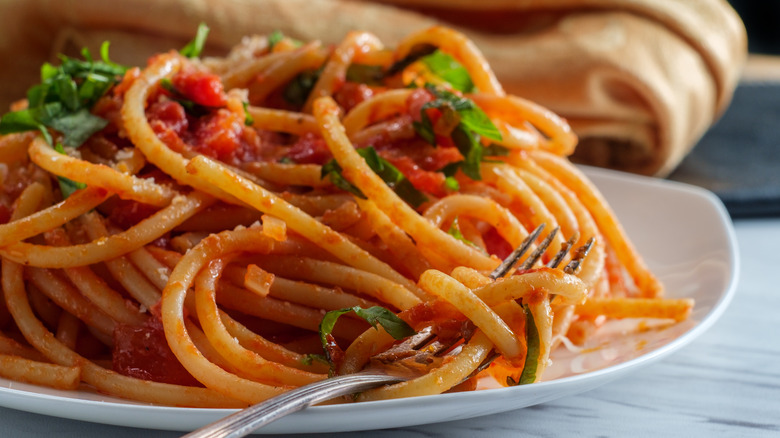12 Facts You Need To Know About San Marzano Tomatoes
San Marzano tomatoes are prized for their sweet taste and strong robust flavor. They have just the right amount of acidity, thick, tender but firm flesh, and they explode with intense, sun-kissed ripeness. They're juicy but not watery, so they make outstanding sauces. Their association with traditional farming in Italy conjures romantic images of agrarian serenity. Some consider them essential, while others see them as a luxury.
People buy them by the case, and certain recipes list them specifically by name. There are entire brands of tomatoes that use the San Marzano name, and others that proudly proclaim to be authentic San Marzano tomatoes. San Marzano is a region, it's a tomato, it's a plant, it's a brand name, it's a consortium. There's a lot of hype — and a lot of confusion — around these exceptional tomatoes. So what are the facts? Let's break down everything you need to know about San Marzano tomatoes.
It's a specific — and highly-sought — variety of tomato
A San Marzano tomato is a specific variety of plum tomato that has been bred over the years for packaging and long shelf life. Well-known varieties of plum tomato include the Big Mama, Amish Paste tomato, and the Roma tomato, with which it is often confused.
Like other plum tomatoes, the fruit of a San Marzano is oblong and contains only two seed compartments. They are red and their appearance is quite similar to Roma tomatoes, but San Marzano tomatoes are thinner and more pointed than Romas. San Marzano tomatoes also have thicker walls, so they're meatier than Roma tomatoes. All plum tomatoes share the quality of fewer seeds than a typical tomato, and San Marzanos are no exception. Fewer seeds mean San Marzanos have a thicker, less watery interior, which makes them an exceptional choice for tomato sauce. Finally, San Marzanos have a stronger, sweeter flavor than their closely-related Roma cousins, so many chefs consider them a must-have ingredient for which there is simply no substitute.
They are grown in a specific place
San Marzano tomatoes are grown in a small area in the Campania region of southern Italy between Naples and Salerno. This agricultural area known as Agro Nocerino-Sarnese is located in the Sarno River valley near Mount Vesuvius, primarily in the Province of Salerno. The tomatoes themselves derive their name from the city of San Marzano sul Sarno, one of 41 towns located within the growing region.
In fact, the Italian government considers the growing region such an important factor for this varietal that in 1996 they gave San Marzano tomatoes an official Denominazione d'Origine Protetta — or DOP — which translates to Protected Designation of Origin. DOPs are a certification that guarantees a product comes was grown and processed in a specific place. It's used for products such as balsamic vinegar, buffalo mozzarella, Parmigiano Reggiano, prosciutto, and olive oils, to ensure quality and certify their origins. It's similar to the regulations around French wines, but in this case, it's about a very specific tomato-growing region. San Marzano tomatoes that meet the strict specifications of the Denominazione d'Origine Protetta are labeled with a DOP seal.
Agro Nocerino-Sarnese has perfect growing conditions
Many varieties of tomato have been grown in Campania ever since tomatoes were first imported from the New World into Italy. But the growing conditions in Agro Nocerino-Sarnese are considered particularly ideal for these special San Marzanos. These tomatoes thrive in a warm, humid climate. The ideal growing temperature for San Marzanos is between 50 and 95 degrees Fahrenheit. In San Marzano sul Sarno, summer high temperatures average about 83 degrees and rarely exceed 95. The Sarno Valley, being a river valley, also has abundant water sources and a consistent level of humidity.
Furthermore, Sarno Valley's proximity to Mount Vesuvius is responsible for its mineral-rich volcanic soils lush with phosphorous and potassium. These fertile volcanic soils are said to produce sweeter, less acidic tomatoes. Temperature, water source, humidity, and soil: these factors combine to make Agro Nocerino-Sarnese the perfect place to grow San Marzanos. It's little wonder the tomatoes from this region have earned a DOP designation.
Not all Italian tomatoes are San Marzanos
Many other types of tomatoes are cultivated throughout Italy and are popular canned exports. Some of the best-known varieties include cherry tomatoes, bulgy heirloom beefsteak tomatoes, and the aforementioned Roma tomato.
Each type of tomato has a slightly different taste and consistency, so they work well for different purposes. For example, the pomodorini is a variety of very sweet cherry tomato that has a bright, fresh flavor, while datterini cherry tomatoes are bold and sweet. Pomodorino del Piennolo del Vesuvio is a sweet cherry tomato also grown in the volcanic soils near Naples. These are frequently sundried to concentrate their intense aroma and sweetness. Costoluto Fiorentino beefsteaks are known for being juicy and slightly more acidic, so they are often sliced and eaten raw. Each of these tomatoes has its own unique characteristics and flavor profiles, however, they are each distinct from San Marzanos. So, while all San Marzano tomatoes are Italian, not all Italian tomatoes are San Marzanos.
Non-DOP San Marzanos are sold in the U.S.
Non-DOP San Marzanos grown outside of the designated region are sold in the United States. As the variety has become more and more popular, demand for San Marzano tomatoes has skyrocketed. To capitalize on the ever-growing consumption levels, some companies now cultivate San Marzano tomato plants outside of the designated San Marzano growing region. It's the same tomato plant simply grown elsewhere. These may be labeled San Marzano-style tomatoes, or even just called San Marzano tomatoes, but they won't have the DOP label certifying their specific origins.
Keep in mind that just because it's the same plant does not mean it will taste exactly the same as the DOP San Marzanos. Growing conditions matter and subtle differences in the climate or soil content have a direct influence on the flavor of any plant product. That doesn't necessarily mean non-DOP San Marzano tomatoes are inherently inferior, but they're certainly going to taste different than the real deal. Ultimately, it's a matter of personal preference, as well as cost and convenience.
You can try growing San Marzano-style tomatoes in your home garden
If you're not concerned about the DOP designation, you can grow the San Marzano tomato cultivar from seeds in your home garden. Seeds are widely available for purchase — but again, since they're grown outside of the Agro Nocerino-Sarnese they aren't considered true San Marzano tomatoes. Still, the plants are the very same as the highly-acclaimed ones grown in Italy, and nothing beats the freshness of a tomato from your own garden.
The original variety is known as Heirloom 'San Marzano' are sometimes called 'San Marzano 2' or 'San Marzano 3.' There are also several hybrids that have been developed specifically to grow in other conditions outside of the San Marzano region. To grow them at home, select a site that gets six to eight hours of full sun per day. All tomato plants love the sun, San Marzanos included. They also need rich soil similar to the fertile volcanic earth found in the Sarno River Valley, so you'll want to add compost, peat moss, or manure to mimic that environment. They also need to be fed with a low-nitrogen fertilizer and given plenty of water, but not so much water that the soil becomes soggy or waterlogged. They won't be DOP San Marzanos, but if you choose to plant San Marzano seeds at home, around 3 months later you'll have a lovely crop of delicious, saucy tomatoes.
There are frauds and fakes on the market
Many of the tomatoes labeled San Marzanos in the U.S. are not real San Marzanos. The DOP is a European Union law, so the rules around the DOP label and San Marzano name are not as strict in the U.S. In fact, only about 5 percent of the San Marzano tomatoes sold in the U.S. are the real deal.
So how can you distinguish real San Marzanos from the fakes? Step one is to look for the yellow and red DOP seal with the words Denominazione d'Origine Protetta on the can. You may also find an IGP — Indicazione Geografica Protetta (indication of geographical protection) — label on Italian tomatoes. This certification is legitimate but less strict than the DOP certification. It traces a food product to its geographical origin during at least one phase of its production, whereas DOP tracks all phases of production.
Unfortunately, there are some unscrupulous companies out there that wrongly apply the DOP seal to non-DOP San Marzanos, or even use the San Marzano name on other tomato varieties. Absolutely look for the DOP label, but you can't rely on that alone since some companies in the U.S. put a fake DOP label on tomatoes exported from Italy. Authentic cans must say "Pomodoro San Marzano dell'Agro Sarnese Nocerino" on them and they will have the DOP seal and a Consorzio San Marzano certification number on the bottom of the can.
Non-industrialized growing and production contributes to their expense
In addition to regulation around the geographic origin of San Marzano tomatoes, the DOP certification enforces rules about the growing conditions, harvest, and processing of the tomatoes. The San Marzano Tomato Protection Consortium of the Agro Sarnese Nocerino mandates that the fruit must be harvested exclusively by hand between July 30 and September 30. It is forbidden to use any artificial means of ripening the fruit, so the individual tomatoes must be picked in several stages as they ripen on the vine.
Since they must ripen naturally, San Marzanos can only be harvested seasonally during that short window each year. The tomatoes ripen throughout the growing season (not all at once) so they must be harvested individually by hand. Highly trained workers pick the tomatoes one at a time as they reach peak ripeness. The regulations also seek to protect against overfarming, specifying that the maximum yield is 80 tons per hectare. A small geographic region, short growing season, limits on production, and a labor-intensive harvest all contribute to San Marzano tomatoes' hefty price tag.
San Marzanos are minimally processed
Tomatoes are so wholesome and naturally delicious, and the San Marzano attitude is not to interfere with them any more than you have to. They are left very close to their natural state, so while San Marzano tomatoes are canned, they remain pure and unadulterated. As the Italian Ministry of Agricultural, Food and Forestry Policies puts it, San Marzano tomatoes are "The only variety that is not damaged by processing, but remains whole and fresh in the can."
Under the DOP rules, San Marzanos can have no preservatives or filler ingredients — only salt and optional fresh basil leaves. This is another way to check the veracity of a can's DOP claim. If you see garlic, or citric acid, or any ingredients besides these tomatoes, salt, and basil, you can bet they are not legitimate DOP San Marzano tomatoes. The light touch in their processing means San Marzano tomatoes arrive in the can still as fresh-tasting, robust, and flavorful as if they were just harvested.
You can only buy them whole or halved
The San Marzano Tomato Protection Consortium also mandates that tomatoes be processed in one of two ways: whole peeled tomatoes, or peeled tomatoes in fillets (cut in half with the inner ribs removed). That's it. There are zero other options for a DOP-compliant San Marzano tomato. If the canned tomatoes you're purchasing are pureed, diced, or chopped, they are not true San Marzanos.
If the tomatoes you're purchasing are not peeled, they are also not authentic San Marzanos, since the two processing options are whole peeled or peeled fillets. Since San Marzanos are often used in sauces, leaving them whole means you can crush them into your saucepan as you're cooking to release even more of their savory juices. Selling them whole or filleted also means these tender fruits hold their shape during storage, so rather than becoming mushy or watery, San Marzanos emerge from the can with their sense of tomato-ness intact.
Traditional Neapolitan pizza calls for San Marzanos
Neopolitan cuisine has a longstanding history with tomatoes. Neoplitans were among the first Europeans to embrace the culinary possibilities of the tomato. At a time when many other cultures feared the tomato or believed it to be poisonous, Neopolitan chef Antonio Latini published the earliest recipe for tomato sauce in 1694, and tomatoes spread from Naples to the rest of Italy, then Europe, and eventually the world.
The relationship between Naples and the tomato — and the San Marzano tomato in particular — has continued throughout history. In 1889, the Neopolitan pizza was invented using local tomatoes, basil, and cheese. Today, Neapolitan pizza (Pizza Napoletana) is a UNESCO Cultural Heritage food. The most classic example of a Neopolitan pizza is the Margherita pizza, which the Italian Standardization Body and the Associazione Verace Pizza Napoletana specifies that the only tomatoes acceptable to use in a Neopolitan pizza are Pomodorino Vesuviano and — you guessed it — San Marzanos.
Dishes that feature big tomato flavors are the best use for San Marzanos
San Marzano tomatoes have a powerful tomato flavor, so they are best in a dish that highlights tomatoes as the star ingredient. They're precious and pricey, after all, so why hide their flavor? Let them shine in a classic red sauce, like scarpariello or puttanesca. San Marzanos would make an enchanting base for a vodka sauce, or you can even use the juice in a bloody mary. Use them as the base for the sauce in baked dishes like lasagna, eggplant Parmesan, or classic manicotti, and see how these tomatoes enhance the experience.
Italian foods are the most obvious choice, but San Marzanos also work well in other cuisines. Use them in a comforting and simple tomato soup with grilled cheese, in sopa de fideos, or try them in a gazpacho. Go even further afield with a hearty Israeli shakshuka to show off San Marzano flavors at breakfast. For any dish that screams "tomato," San Marzanos are a sure bet.
